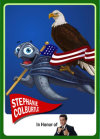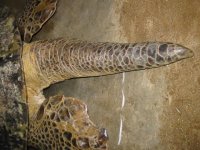The Birds and the Bees of Leatherbacks

When I was writing up the last post on the Great Turtle Race, I came across this Wikipedia page that has details on every Colbert report ever (what doesn’t Wikipedia have?). It included this quote on Stephen Colbert’s leatherback:
Stephen is unhappy at the fact that Stephanie Colburtle The Turtle did not win The Great Turtle Race, after being bested by another turtle named Billy. He claims Billy is a male, and demands a re-race. (After explaining that one can tell the sex of a turtle by the concavity of its plastron, Stephen says that he checks the plastron on “all [his] dates, and if it’s not concave, [he is] outta there.” However, a concave plastron denotes a male turtle.)
Now I’m not totally sure the concave plastron bit works with leatherbacks since they’re more barrel-shaped than turtle-shaped but I guess it’s possible. But on the topic, I just thought I’d share a couple tips for determining leatherback sex.

First, is it on a beach? If so, it’s female. Healthy male leatherbacks never return to land after their initial crawl from the nest to the ocean. That makes research programs that catch turtles at sea the only way to look at male leatherbacks.
Second, does it have a long tail that trails well behind the shell? Then it’s a male. Leatherbacks (and other sea turtles) store their penis in their tail. The tails of female turtles barely extend past their shell. The tails of male turtles, shall we say, hang low and wobble to and fro. I couldn’t dig up a picture of a male leatherback but here’s a picture of a male green sea turtle tail (from seaturtle.org courtesy of Daha Diew and Alain Gibudi) that should give an idea (that’s its rear flippers in the left edge of the picture).
And now you know.